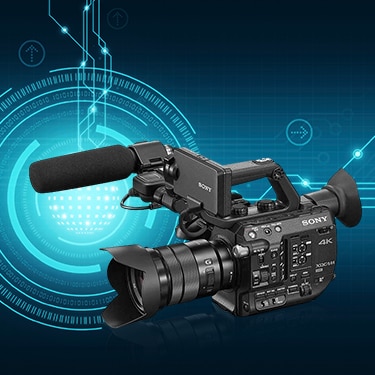Mohamed El Sehrawy's first impressions of Sony's FS5 camcorder
When Sony contacted me about producing a short film about their new FS5 camcorder, it seemed obvious that the best way to do this was to take it travelling.

“If you put all of the technical aspects of the FS5 aside, you’ll find that its strongest point really is its size and its weight. As it’s so small, so light, it makes a fantastic documentary camera and a fantastic camera to just go out into the world and shoot. Because the camera is so unintimidating, it was so easy to take it everywhere.”

On location
The review was mainly shot around Dahab in Sinai by the Red Sea. We filmed there at a restaurant and by the sea. From Dahab, we went to Nuweiba and to Wadi Erada. This is where we shot all the mountain, hiking and Bedouin scenes. We also went to Castle Zaman, which is a truly astonishing place to visit but sadly, we weren’t allowed to shoot more than a single shot there.
After that, we headed to South Egypt. All the way down to Aswan where we lived for a week on Haisa island. Our friends there work as boatmen, taking tourists up and down the Nile between ancient Egyptian temples. The temple we shot at was Philae Temple. In addition to this, we would stop at random places on our way and film whatever we met on our way that felt right.
As for the kit I used on the shoot, I had one pre-production FS5 – very rare at the time of the shoot – and my own personal NEX-FS700 to shoot the FS5 itself. It was Sony gear all over the place.
Hands-on with the FS5
At the heart of the FS5 is Sony’s highly impressive Super 35mm sensor, which was originally developed for the F5 CineAlta camera. In the FS5, it offers 4K resolution and can record at up to 30fps. It has 14 stops of dynamic range and because the E-mount is so flexible, you can use pretty much any lens you want provided you have the appropriate adapter.
From a photographer’s point of view, the grip of the FS5 feels very familiar, it’s almost as if you’re shooting with a stills camera. And thanks to the flexible grip and low centre of gravity, the balance of the camera – particularly when you use one of the larger batteries – means your wrist does not get tired even after several days of handheld shooting. This makes it a real go-everywhere, every day camera in my opinion
Compared to DSLRs, the FS5 has a longer form factor which makes for far more stable shots when panning and tilting handheld. The larger form factor also allows for more buttons to be placed on the body of the camera so much less time is wasted searching through menus: adjusting camera settings is fast and intuitive. As a FS700 user, it took me less than two hours to get acquainted with the FS5, which speaks volumes about how well designed the FS5 is.

Thanks to the flexible grip and low centre of gravity... your wrist does not get tired even after several days of handheld shooting. This makes it a real go-everywhere, every day camera.
I also really appreciated the FS5’s variable neutral density filter which made shooting in the bright Egyptian desert so much easier than with a conventional camera. In comparison to most mainstream DSLRs, rolling shutter is also much more under control on the FS5 and light years better than another one of my favorite Sony cameras; the A7S. As with the FS700 and FS7, the FS5’s slow motion capabilities are impressive and help expand the artist’s creative freedom.
The FS5’s built in OLED electronic viewfinder was a joy to use because of its excellent responsiveness and accurate rendition. Its size means it’s obviously not your primary viewfinder, which is where the FS5’s external LCD proves to very handy. I can not stress enough the importance of the fact that it can be mounted in three different positions. The flexibility of such a lightweight camera would be seriously compromised if it wasn’t matched with such an easily adaptable LCD.
No camera is perfect and the FS5 is designed to be affordable as well as compact. It’s not as fully specced as the FS7, of course, but I’m looking forward to the V2 firmware with support for FSRAW capabilities.
Overall, I think the FS5 is a significant leap forward in camera design. Its size and weight are truly astonishing – especially when you see the punch it packs. After intensively using the FS5 on this shoot, I concluded its ergonomics and overall design are a massive step forward compared to the FS700 – a camera we all know and love.

Additional information
Mohamed El Sehrawy is an Egyptian director with an eight-year-long background in photography and cinematography. After discovering his passion for photography, he dropped out of a career in engineering to pursue this dream. When studying at the Met Film School in London, he won the 2013 Sony Production Awards with his short abstract film ‘For Granted’ which helped catapult him into the realm of filmmaking. He now has a large fan base in his home country and also enjoys teaching photography.

